Leonardo da Vinci was an Italian Renaissance painter. The Mona Lisa and The Last Supper, which Leonardo da Vinci painted, are two of the most reproduced and influential paintings of all time. But he wasn’t born with a silver spoon in his mouth. In his biography of Leonardo Da Vinci, Walter Isaacson portrays him as illegitimate, gay, vegetarian, left-handed, easily distracted, and at times heretical. But he eventually became a polymath whose interest spread over varied fields of discipline, like science, sculpting, architecture, and engineering. His foresight and knowledge in all these fields amaze historians even today. Certainly, he was a great thinker who was ahead of his times. Read this biography of Leonardo da Vinci and find out how he became a legendary painter, sculptor, inventor, and architect.
What is the Renaissance?
Due to the rise in religious art, the medieval ages killed fine arts like Roman and Greek art. In the fourteenth century, some rich Italian families decided to end Christianity’s domination in arts. They decided to create art that was based on the worth and dignity of the individual. This gave rise to the Renaissance, which is the revival of fine arts of the Iron age.
If you want to read more about how art has evolved over the ages and find out more about the Renaissance in detail, read our blog post on the history of art.
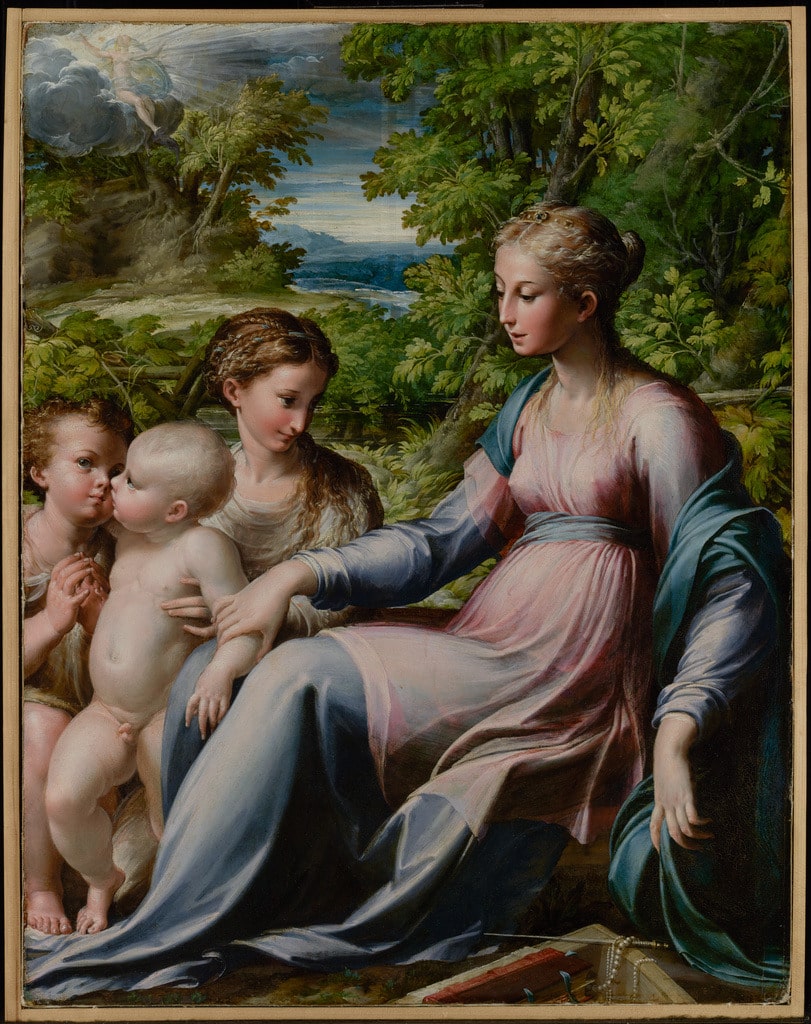
Parents
Vinci
32km West of Florence lies Montalbano. On the slope of this hill lies a town called Vinci. In the twelfth century, a castle was built at the top of the hill. As it looked like a ship, it soon got the name ‘ship castle‘. Today, the castle has become a Leonardo Da Vinci museum. At the time of Leonardo Da Vinci’s birth, it would have served as the center of the city.
Leonardo’s grandfather, Antonio Da Vinci, lived on a modest income. He was a farmer who was by no means rich. But he paid his taxes diligently to Florence’s tax authorities. According to Florence’s tax register, which is still preserved in the archives of Florence and Pisa, Antonio’s income was below average. Only 40% of the people of Florence had less income than him.
The inequality in Florence at that time was extremely high. The top 20% of the population had incomes nearly 25 times higher than the bottom 20%. In Florence and its surrounding towns like Vinci, the poor people worked as agricultural laborers in nearby farms owned by wealthier residents. The only assets they had were small pieces of land which they inherited from their fathers. Even though these lands were uncultivable individually due to their small sizes, these agricultural laborers sold these farms whenever they needed money. Thus, people often fought amongst themselves over the issue of inheritance and distribution of land.
Who was Leonardo da Vinci’s father
Moreover, the rich bought off lands from the poor whenever they had a chance. Whenever someone bought or sold a piece of land, or whenever one sibling won the case of inheritance of property against another, one person always got richer. That person was the lawyer who represented the person.
Antonio’s son, Piero di Antonio da Vinci, worked as a lawyer and a notary in Vinci. As a lawyer, he was highly successful. So, many people came to him to solve land disputes. He was also the notary for many religious institutions and legal advisory for many wealthy families in Vinci and Florence. Thus, in contrast to his father, who had only a modest income, Piero ended up becoming extremely rich. He also continually improved his status by purchasing new assets in Vinci. At times, he even purchased land from the poor agricultural laborers.
Who was Leonardo da Vinci’s mother?
This Piero was Leonardo Da Vinci’s father. While Leonardo’s father is well-known in history, his mother’s identity is unclear because Leonardo was an illegitimate child. When Leonardo da Vinci was born, his grandfather recorded his birth. In this record, he mentions his mother’s name simply as Caterina. He doesn’t mention her full name. So, there are many theories as to who his mother was. According to one of these theories, Caterina was either a slave from the Middle East or even from China. According to another theory, she was a poor local girl.
However, research done by Martin Kemp and Giuseppe Pallanti sheds more light on who his mother was. They have published their findings in the book called ‘Mona Lisa, The People, and the Painting‘ in 2017.
According to them, the brothers called Lippo di Nanni and Giusto di Nanni lived in Mattoni, not far away from Vinci. For his marriage, Lippo took dowry from his wife’s family. However, Lippo died early, leaving his wife and son behind. So, after his death, his wife demanded that the dowry she paid her husband to be returned to her. In those days, it was normal for the wife to demand her dowry back if the husband died. However, this led to disputes between her and her son. Eventually, the court gave most of Lippo’s property to his wife. So, her son Meo led a pathetic life and died early, leaving a 15-year-old daughter and a two-year-old son. This 15-year-old girl, Caterina di Meo Lippi, would later become Leonardo’s mother.
Birth
After her son’s death, Lippo’s wife took in her grandchildren to live with them. However, she also, died soon after, leaving the children alone and uncared for. But the children at least had a house to live in. It is during this time that the 25-year-old, rich, and spoiled Piero di Antonio da Vinci met the 15-year-old, poor, and lonely Caterina di Meo Lippi. As one could imagine, it might not have been difficult to woo the lonely girl. Thus, they might have gotten together. As a result, Caterina gave birth to Leonardo di ser Piero da Vinci a year later, on April 15th, 1452.
Early life
After being born, Leonardo spent his first years with his mother. But Leonardo was an illegitimate child. His father and mother weren’t married at the time of his birth. Indeed, his father never married his mother, probably because he was rich and she was poor. Instead, he just gave her the dowry so that she could give it to another suitor and get married.
In those days, it was not uncommon for wealthy men to have children with their servants or other poor women in the village. These children would then grow up in their father’s house with their half-siblings who were the rightful heirs. So, even though Leonardo was an illegitimate son, his Paternal grandfather took the 5-year-old Leonardo to his father’s estate. After that, Leonardo lived with his father, stepmothers, uncle, and grandparents. His uncle Francesco, a nature lover, had a profound impact on Leonardo during his early years.
When Leonardo came to live with his father, Piero, Piero had married a 16-year-old girl. This girl, Piero’s first wife, loved the little Leonardo like her own son. However, she died a few years later, without bearing any children. Thereafter, Piero married once again, and his second wife, too, died without bearing him any children. After that, he married twice. Both these third and fourth wives gave birth to plenty of children. In total, Piero had 13 children, including Leonardo. However, Leonardo was his illegitimate son. So, he couldn’t inherit any of Piero’s wealth.
Becoming an artist
Formal Education
Leonardo had no formal schooling. Since he was born illegitimate, his father did not expect him to take up his notary business. Moreover, expert teachers would not accept him as their student. So, he only learned to read and write and obtained basic Mathematical knowledge at home. But eventually, this became an advantage for Leonardo in the long run. After all, unrestricted by the dogmatic authority of teachers, Leonardo Da Vinci developed the ability to think creatively.
Growing up, Leonardo might not have been quite knowledgeable due to the lack of formal schooling. Yet, his skill at artistry was evident even from an early age. When Leonardo was a kid, there was a peasant who was good at fishing and catching birds. Once, this peasant, who wanted to have a shield, made one himself from a fig tree. Then, he gave it to Piero and requested him to get it painted for him. Since this peasant’s skills often came in handy for Piero, Piero decided to help the peasant. So, Piero gave the shield to his son Leonardo.
First recorded painting
Leonardo, who saw that the shield was very uneven and badly made, first straightened it by fire and gave it to a lathe worker to make it smooth. Then, he decided to paint something scary on it. So, inspired by Greek mythology, he painted a picture of Medusa, with smoke coming out of her nostrils, fire coming out of her eyes, and venom coming from her open throat. Then, he kept the shield in a place where there was enough sunlight and called his father Piero to look at it. The picture was so realistic that upon his first sight, Piero was startled. Then he took a step back and, after an instant, realized that it was only a painting.
Looking at Piero’s reaction, Leonardo told him, “This work serves the end for which it was made; take it, then, and carry it away, since this is the effect that it was meant to produce.” Piero immediately realized that his son’s painting was a miracle. But he did not want to give the painting to the peasant. So, he sold the painting to some merchants in Florence. After that, he bought another shield. Then, he had someone paint a heart with an arrow through it, and gave it to the peasant.
Leonardo’s painting of the Medusa revealed to Piero his son’s innate talent in painting. So, he got him an apprenticeship from Andrea del Verrocchio, a famous painter, and sculptor in Florence.
The Medici family
There were several powerful families in Florence during the Renaissance. One of these families was the Medici family. In 1397, Giovanni di Bicci de Medici moved to Florence and established the Medici bank. Within a span of few decades, the Medici bank became the largest and most respected bank in Europe. Soon the bank became the most trusted bank of the Popes. Moreover, after their success in banking, the family also entered other businesses and dominated them. So, the family became the most powerful family in Florence and Tuscany (A region in Italy. Florence is the capital of Tuscany). The family held this position for the next three centuries.
The Medicis played a major role in the Renaissance’s growth in Italy because they were great patrons of art and humanism (human virtues like courage, beauty). Artists, both big and small, benefited from their generosity.
Today, people respect specialists who specialize in just one field. So, someone with a post-graduate degree or doctorate earns a lot of respect. However, in the renaissance era, men needed to have various talents to earn people’s respect. This is why a person who is skilled in multiple fields is called a renaissance man even today. So, most of the renaissance era artists were knowledgeable in various fields. Verrocchio was not an exception to this custom.
Andrea del Verrocchio
Verrocchio underwent training to become a goldsmith. But he was also good at painting, sculpting, designing monuments, machinery, and creating theatrical costumes. So, he caught the interest of the Medicis and soon become their most trusted artist. And as Medicis’ most trusted artist, he got a lot of painting and sculpting projects. So, Verrocchio was almost always busy. Verrocchio himself focussed primarily on sculpting. When it came to painting, he often painted only a part of the painting. Then, he directed his apprentices on how to paint the rest of it.
So, several budding artists wanted to become his apprentice. After all, they could learn state-of-the-art techniques from Verrocchio while attracting the attention of generous patrons. Some of these apprentices later became famous artists of the renaissance era.
Leonardo becomes an apprentice
Leonardo Da Vinci was 14 years old when he became an apprentice to Verrocchio. For the next ten years, Leonardo learned from him meticulously.
Initially, as an apprentice, Leonardo was more of a studio boy or a servant, doing daily chores like cleaning. Then after three years, his apprenticeship began. Initially, he would have learned to prepare pigments, the substance used to make paint colors, and canvas, the strong, woven cloth stretched over a wooden frame on which artists paint. Later, he would have learned to study the paintings of Verrocchio and others. Finally, he would have learned to paint and would have painted along with Verrocchio in his paintings.
But drawing and painting are not the only things that Leonardo learned from Verrocchio. He also learned sculpting, carpentry, leather arts, chemistry, woodworking, and metalworking. Most paintings and sculptures in the renaissance era depicted the glory of the human body. To depict the beauty of the human body, it is essential to understand it in the first place. So, Verrocchio also insisted that his students develop a deep understanding of anatomy and physiology.
Moreover, Leonardo also met other apprentices in Verrocchio’s workshop. Some of them, like Domenico Ghirlandaio, Lorenzo di Credi, Filippino Lippi, would later become famous artists in their own right. Leonardo could have even met Sandro Botticelli there. Thus, Leonardo spent his time in Verrocchio’s workshop learning from Verrocchio and observing other great minds at work. Hence, the apprenticeship changed Leonardo’s life completely. It implanted in young Leonardo, an illegitimate child whom teachers wouldn’t teach, a desire to gain expertise in several fields.
Leonardo becomes a master artist
In Leonardo’s times, cities had guilds. A guild is, in simple words, an association of like-minded people. A guild for artists is a guild for artists, sculptors, art dealers, and art lovers. It settled disputes between artists as well as conflicts between an artist and his clients. Moreover, an artist needed guild membership, as a master, to sell paintings on his own or accept apprentices. Thus, guilds controlled the livelihood of artists.
The Guild of Saint Luke was a guild for artists in Florence. In 1472, after three years of apprenticeship, Leonardo qualified for this guild’s membership as a master artist. Leonardo was 20 years old at that time. So, now that Leonardo could sell paintings on his own, his father set up a workshop for him. But even after having his own workshop, Leonardo worked with Verrocchio for another five years.
One of the paintings which Verrocchio and Leonardo painted together was the ‘Baptism of Christ.’ Historians believe that Verrocchio completed this painting in 1475. In this painting, Leonardo painted an angel. According to Giorgio Vasari, the sixteenth-century painter, engineer, architect, and writer who wrote the first biographies of Leonardo and other renaissance painters, Leonardo’s angel was so superior to the rest of the painting, that Verrocchio swore never to paint again. This, however, could have been an over-exaggerated story. Maybe, realizing Leonardo’s talent in painting, Verrocchio decided to let him take care of his workshop’s paintings. He would have then focused on sculpting and carving, which he liked and excelled in, more than painting.
Was Leonardo da Vinci homosexual?
In 1476, while he was still working at Verrocchio’s studio, Leonardo da Vinci and three other young men were arrested. According to the court records, they were accused of having sex with a well-known male prostitute. However, despite the crime being punishable by exile or death, the court dropped the charges due to lack of evidence. Probably because one of the other men belonged to the Medici family, nobody turned up to testify against the accused. Thus, luckily, Leonardo was saved. However, this incident might have scarred him deeply because his whereabouts went entirely undocumented for the next two years.
This incident has led many historians to believe that Leonardo was homosexual. However, although Leonardo never married nor had any children, his homosexuality has not been proven. Even though Leonardo Da Vinci was a famous artist, and his professional life has been very well documented, it is amazing how we know very little of his private life.
Two years after the drama surrounding his sexuality, Leonardo da Vinci left Verrocchio’s workshop in 1478. His first job was to paint an artwork behind the altar of the chapel in the Townhall of Florence. Three years later, he also got another commission from another church in Florence to paint a portrait of the Virgin Mary and child Jesus.
During those days, humanist philosophers, who valued human virtues like bravery and heroism over religion, often gathered at Medici’s house. Leonardo also visited Medici’s house along with a friend who was also a philosopher. So, he got to know the Medicis well.
Milan
In 1482, the Medicis planned to send a gift to the Duke of Milan, Italy, as a gesture of peace. So, they commissioned Leonardo to create a piece of art. Even though Leonardo was getting painting projects in Florence, art wasn’t the only thing that interested him. By then, his interest had expanded to engineering as well.
At that time, Milan held a strategic position in Southwestern Europe. So, it spent a lot of money on enhancing its military. Hence, even though Florence was more artistically centered than Milan, Milan provided an opportunity for young Leonardo to pursue his varied interests. So, along with the piece of art, Leonardo also sent a letter to the Duke of Milan. In this letter, he explained that he could work as an artist as well as a military engineer creating machines to enhance the city’s defense and offense. Then he went to Milan. After receiving the piece of art and his letter, the Duke sent him an offer to work as his court’s resident artist. So, leaving both the paintings he was commissioned in Florence unfinished, he traveled to Milan.
For the next 17 years, Leonardo stayed in Milan. During this time, he designed several military machines, including a wild chariot with blades attached to its wheel and a primitive war tank. The Duke of Milan also commissioned Leonardo to paint several paintings. It is also during this time that Leonardo started accepting apprentices and assistants to work under him.
Studying anatomy and science
Leonardo believed that mankind’s biggest gift was the eyes. For him, accumulating knowledge and collecting facts through observation was of utmost importance. He also believed that to paint a human body perfectly, one should understand the human body first. Therefore, to improve his paintings, Leonard began studying anatomy by dissecting animal and human bodies in the 1480s. He then drew diagrams and illustrations of the different organs and systems in the body. By doing so, Leonardo became the first artist to cut open the human body and draw what he saw inside.
But Leonardo’s interest did not stop with human anatomy. He also conducted investigations in botany, zoology, geology, physics, hydraulics, and aeronautics, in addition to anatomy. He then sketched the observations from his experiments on sheets of paper. Leonardo da Vinci even kept some of these papers tucked inside his belt so that he could sketch whenever he wanted to. Once he finished the sketch, he arranged it into one of the four broad categories – painting, anatomy, architecture, and mechanics. Some of these sketches, which are preserved even today, help us understand Leonardo’s yearning to know everything.

Close up of Old anatomy drawings by Leonardo Da Vinci

Close up of Old anatomy drawings by Leonardo Da Vinci

Close up of Old anatomy drawings by Leonardo Da Vinci

Close up of Old anatomy drawings by Leonardo Da Vinci
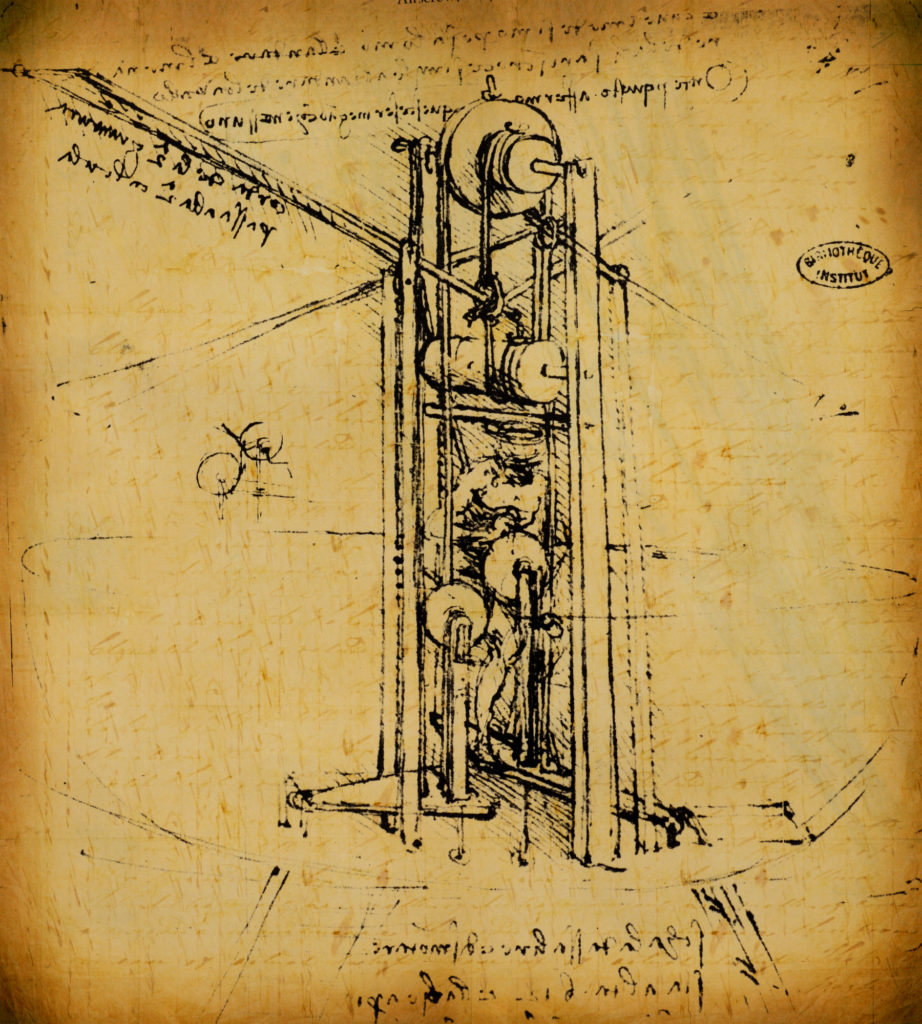
Leonardo Da Vinci’s engineering drawing from 1503 on textured background.
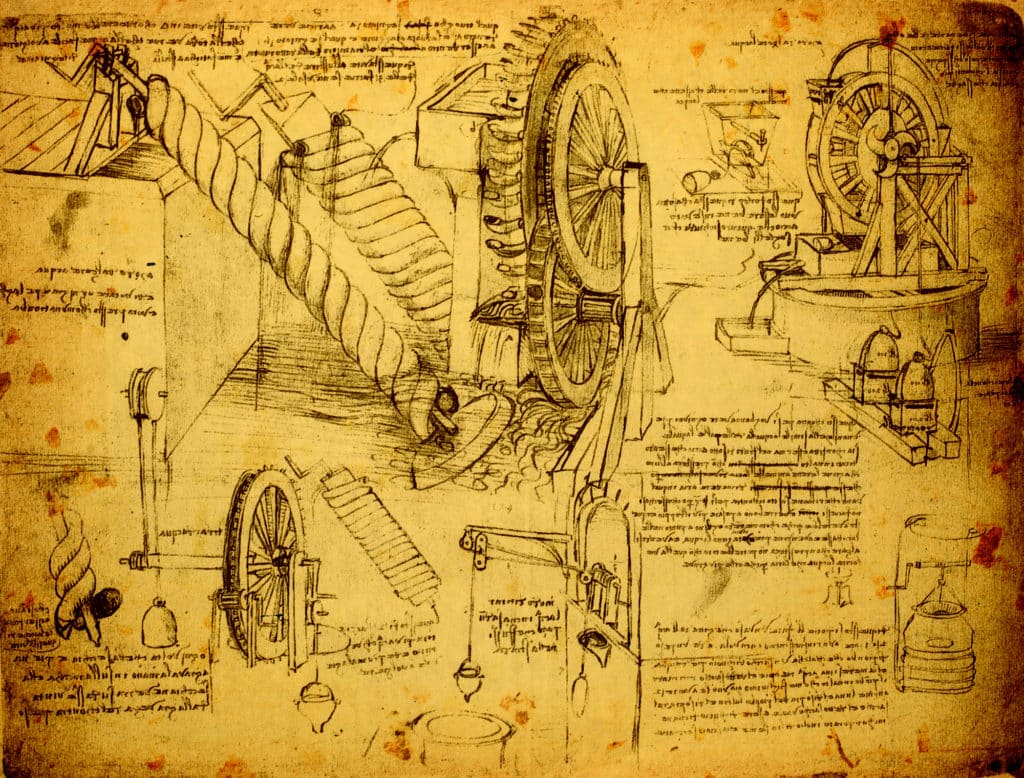
15th Century Leonardo da Vinci engineering drawing
The Vitruvian man
Vitruvius
Marcus Vitruvius Pollio was a Roman architect, engineer, and author who lived in the first century B.C. He believed that, for buildings to be beautiful, they must have perfect proportions and symmetry, like those found in nature. In those days, people thought that nature’s most perfect creation was the human body. So, Vitruvius argued that a building should have proportions similar to the human body.
For Vitruvius, the temple was the ultimate building since it was a place of worship and was close to god. The base of the temple is a square, but the base of the dome on top is a circle. Thus, when seen from the sky, the temple would look like a square within a circle. This square would have the same center as the circle, and its vertices would touch the circle. So, he theorizes that a human body should have proportions similar to a temple and obey a similar concept. In the third book of his ‘Ten Books on Architecture’, he lists the different proportions of the human body, like the ratio between the height of the head to the height of the human body, etc, and goes on to explain his theory.
Vitruvius’ challenge
To understand his theory, let’s assume that a man stands with his legs and hands outstretched. His hands are outstretched in such a way that a single line can be traced from the fingertips of one hand to another. Then, a circle can be drawn touching the edges of his feet and the fingertips of both his hands. This circle would have its center at the navel. Now, it should also be possible to draw a square whose one side touches the head, the opposite side touches the feet, and the two remaining sides touch the fingertips of each hand. In other words, the man’s height should be equal to the length of his outstretched hands.
During Leonardo’s time, Vitruvius’ book, the earliest surviving Roman record on architecture, came out in print. So, sketching a human body satisfying Vitruvius’s criteria became a challenge that attracted artists. Many of them drew sketches assuming that the circle and the square had the same center – the navel. However, all these sketches appeared wrong because they either sacrificed the human body’s proportions or the geometry of the square and the circle so that the human body can touch both the square and the circle, and the vertices of the square can touch the circle.
Leonardo’s solution
The challenge got the attention of Leonardo da Vinci, too. However, unlike other artists, he did not assume that the circle and the square had the same center, the navel. Instead, he used the navel as the center for the circle and the groin as the center for the square. Leonardo knew he had to draw a square with the man’s head, two hands, and legs touching one side each. He also knew he had to draw a circle with the man’s legs and two hands touching the circle. So, he decided to achieve it by moving the square downwards and separating the centers of the two shapes.
Then, he started sketching the human body by using the proportions he had obtained by meticulously studying Vitruvius’ book and by measuring the bodies of male models in Milan. Finally, he perfected his sketch by drawing two distinct and mutually exclusive poses and finished it around 1490. Due to these two distinct poses, the man is both inside the circle and the square at the same time. Thus, Leonardo created a sketch that satisfied Vitruvius’ criteria, even if the square did not fit inside the circle. This sketch came to be known as the Vitruvian man.
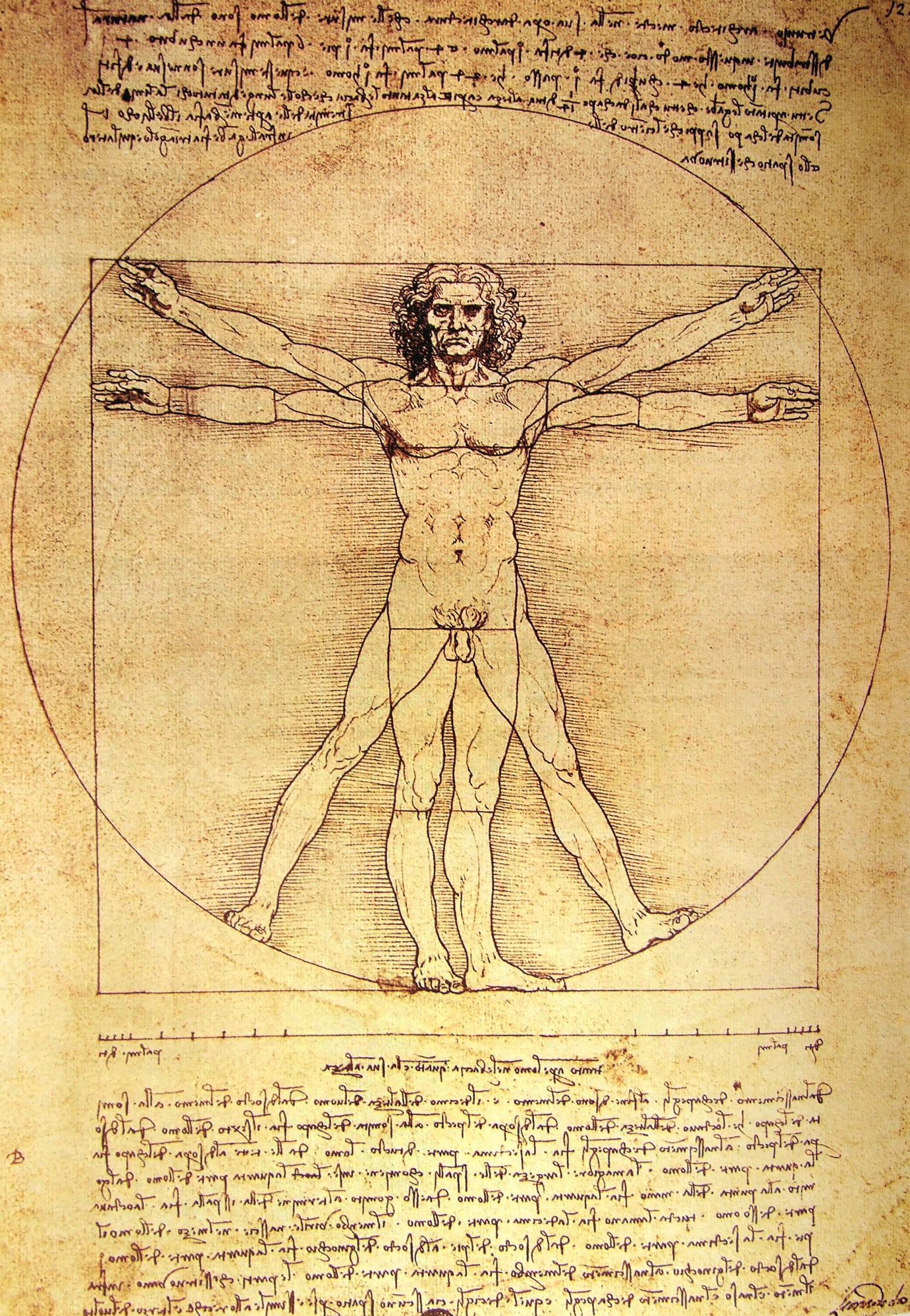
Photo of the Vitruvian Man by Leonardo Da Vinci from 1492 on textured background.
Incorporating the element of movement
The two distinct poses that Leonardo drew serve another vital purpose besides satisfying Vitruvius’ criteria. For centuries, several artists have used different techniques to create a sense of movement in their paintings. They used contrasting colors, strong brushwork, painted moving or flowing clothes, etc. After all, it makes the painting look more real. In this sketch, Leonardo created an illusion of movement by painting two different poses. If you look at his sketch carefully, you will make out 16 different poses, making it look as if the man is actually moving.
The sketch is also accompanied by notes on the proportions of the human body. These proportions, like, the length of the outspread arms is equal to the height of a man; the length of the hand is one-tenth of the height of a man; the foot is one-seventh of the height of a man, help us understand how much work Leonardo put into this sketch. To date, this drawing and its accompanying notes serve as one of the accurate descriptions of the human body.
The Last Supper
In 1495, the Duke commissioned Leonardo to paint ‘The Last Supper’ on the dining hall of Santa Maria Delle Grazie, a church in Milan. It took Leonardo three years to complete the painting. But when Leonardo da Vinci completed it, it caught everyone’s attention. The painting depicts the scene where Jesus and his twelve disciples are having dinner. Jesus informs his disciples that one of them would betray him soon. The resulting confusion is brilliantly captured by the painting.
While the other disciples are in an argument over Jesus’ statement, Judas, the disciple who betrays Jesus later, can be seen reaching out for the same piece of bread that Jesus is reaching out for, at the same time, and tipping over a jar containing salt. He also clutches a cloth bag. This is a reference to the silver coins he got for betraying Jesus or his role as Jesus’ treasurer. Peter, the other disciple who betrays Jesus later by denying to know Jesus after Jesus is arrested, can be seen holding a knife. Thus, Leonardo uses the body language and facial expressions of the twelve disciples to bring the scene back to life.
Besides paintings, the Duke also commissioned to design an equestrian monument to honor his father. An equestrian monument is the statue of a rider on a horse. This bronze statue would have been a splendid work of art. However, Leonardo never completed it because the Duke never provided the bronze needed for it.
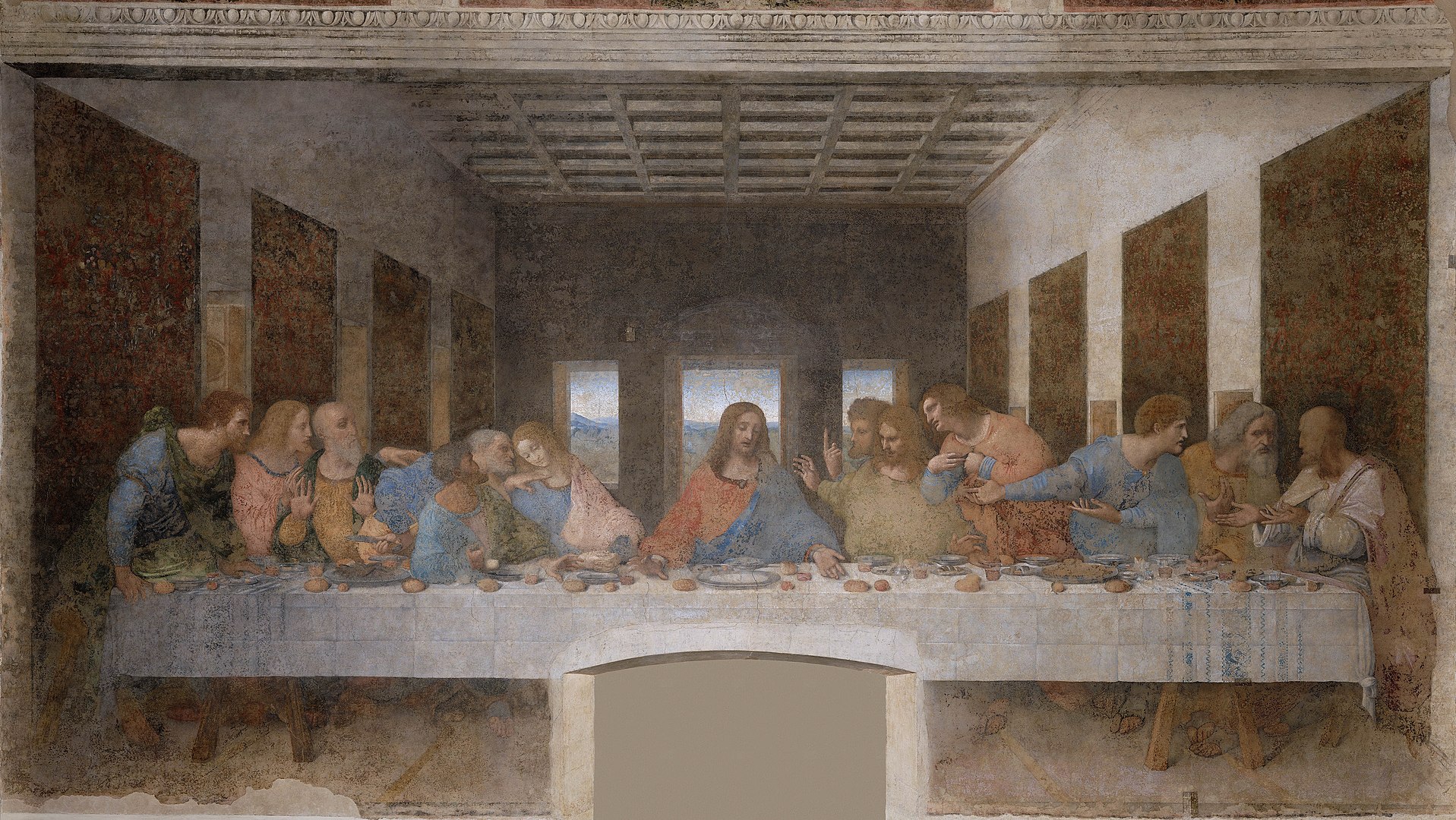
The Last Supper – By Leonardo da Vinci – High resolution scan by http://www.haltadefinizione.com/ in collaboration with the Italian ministry of culture. Scan details, Public Domain, Link
Florence
Thus, as he had hoped, Milan provided Leonardo ample opportunities to pursue his interest in varied fields. If he had a choice, Leonardo might have stayed there for his entire lifetime. However, in 1500, French king Louis XII’s forces attacked Milan, defeated Duke’s forces, and overthrew him. So, along with his assistants, Leonardo fled to Venice. In Venice, the governing council appointed him as a military engineer. They sought his help to fight a Turkish invasion. So, he devised methods to improve their naval defense and returned to Florence the same year.
Mona Lisa
After staying in Florence for some time, Leonardo went to Cesena, a city located almost a hundred kilometers northeast of Florence. There, he worked for Cesare Borgia, a politician and son of the Pope at that time. As Cesare’s military architect and engineer, Leonardo created two maps for him. These two maps, the map of a town and the map of a valley helped Cesare get a better overlay of his land to make better strategic decisions.
One year later, Leonardo moved to Florence and joined the Guild of Saint Luke once again. It is during this time that he began painting the Mona Lisa.
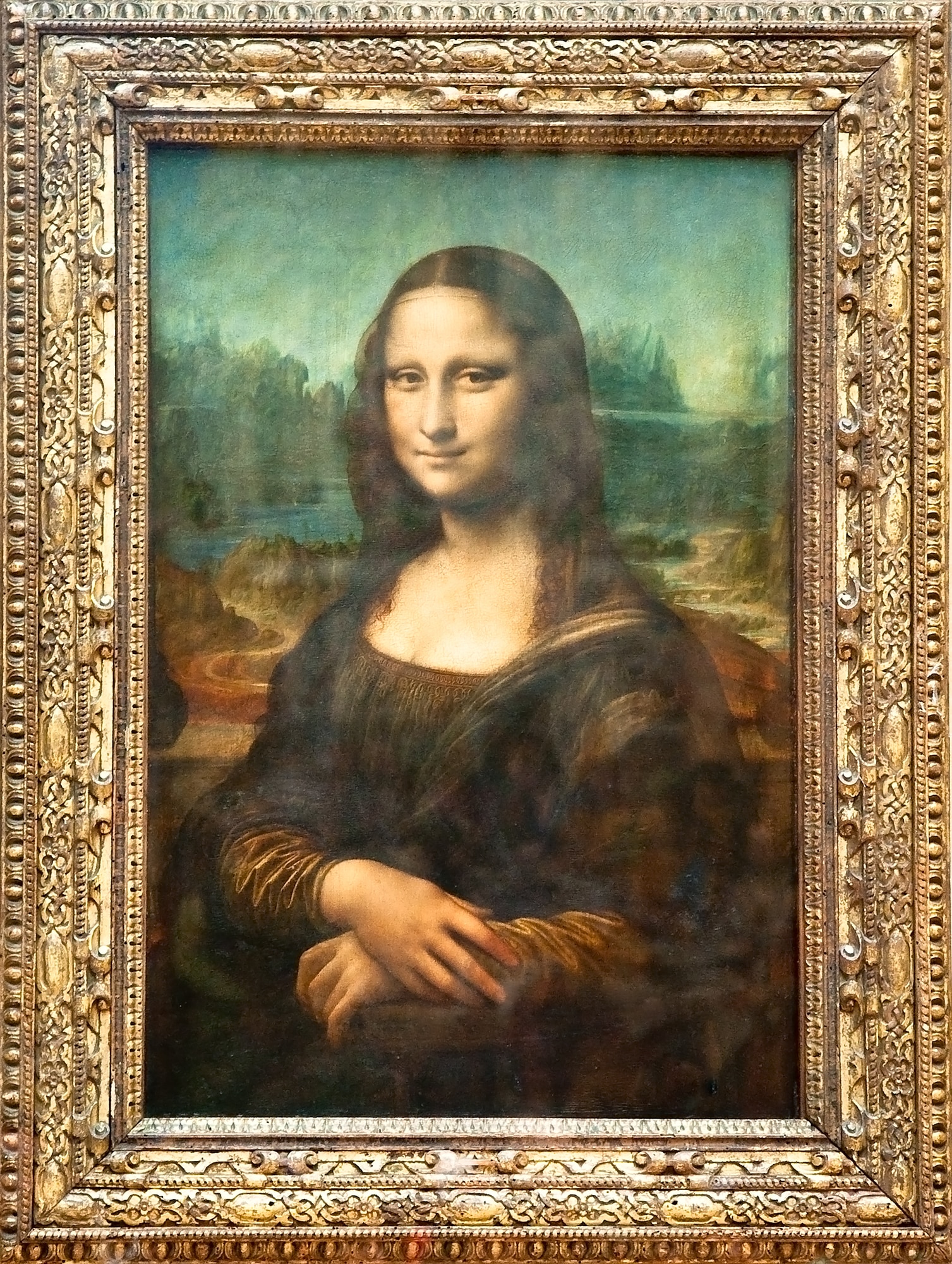
The Mona Lisa
Who was the Mona Lisa?
Throughout history, there have been many theories as to who the Mona Lisa was. Some people believed that it is a portrait of Lisa del Giocondo, the wife of Francesco del Giocondo. Some others believed that the mysterious smile of Mona Lisa indicates that she is Leonardo’s mother, Catarina. Meanwhile, others believed that Mona Lisa is a self-portrait of Leonardo or one of his male apprentices dressed as a female. In 2005, historians found a 500-year-old note from an acquaintance of Leonardo. In this, the acquaintance states that Leonardo was indeed working on a portrait of Lisa del Giocondo, thus confirming the first theory.
Why did Leonardo da Vinci paint the Mona Lisa?
During Leonardo’s days, men married around the age of 25. On the other hand, women married early around the age of 15, often immediately after reaching puberty. The foremost responsibility of a wife was to produce heirs for her husband. In turn, it was customary for the husband to give the wife a gift whenever she gives birth. Rich husbands often gifted their wives expensive jewelry when they gave birth. In a similar fashion, Francesco probably wanted to give his wife Lisa a gift celebrating the birth of their second son. So, he commissioned Leonardo to paint a picture of his wife.
After Leonardo returned to Florence in 1503, he did not have any source of income. So, he agreed to paint the portrait of Lisa. However, soon he got the commission to paint a battle scene of Anghiari.
The battle of Anghiari was a battle that took place in 1440 between the troops of Milan and some other Italian states led by Florence. Florence won this battle and took control of central Italy.
Why was the Mona Lisa never completed?
In 1503, Florence commissioned Leonardo da Vinci to paint the Battle of Anghiari for its newly rebuilt council hall. It was a costly project and Leonardo had to complete in two years. So, he started painting the Battle of Anghiari and delayed the Mona Lisa. While Leonardo painted the Battle of Anghiari, Leonardo’s rival at that time, Michelangelo, was commissioned for a similar painting of another battle on the opposite wall. This is the only time the two legends and rivals worked on the same project. However, neither of them finished their paintings.
In 1506, the French governor of Milan summoned Leonardo. So, he went to Milan, leaving the Battle of Anghiari unfinished. He took the unfinished Mona Lisa with him and continued painting it in Milan.
In 1512, a union of Venetian, Swiss, and Spanish forces attacked Milan and defeated the French troops. So, in 1513, Leonardo da Vinci left Milan for Vatican city to visit Giovanni, a member of the Medici family, who had recently become the Pope. He stayed in the Vatican city until 1516.
In 1516, King Francis I, who recaptured Milan, invited Leonardo da Vinci to stay with him. So, Leonardo went to France and stayed near the king’s residence. The king soon came to like Leonardo due to his intelligence and started spending time with him. When he lived in France, Leonardo created plans for the king to create a settlement surrounding a castle. He also made the Mechanical Lion. This automatic machine could walk a few steps on its own and open its chest to display a cluster of lilies for the king. At the same time, Leonardo also continued to paint the Mona Lisa and add different layers to it.
Death
During his years in France, Leonardo likely suffered a stroke that left his right hand paralyzed. This is probably why he couldn’t finish the Mona Lisa. He probably kept on improving it and adding more layers to it.
Leonardo da Vinci probably suffered a second stroke in 1519 at the age of 67 that killed him.
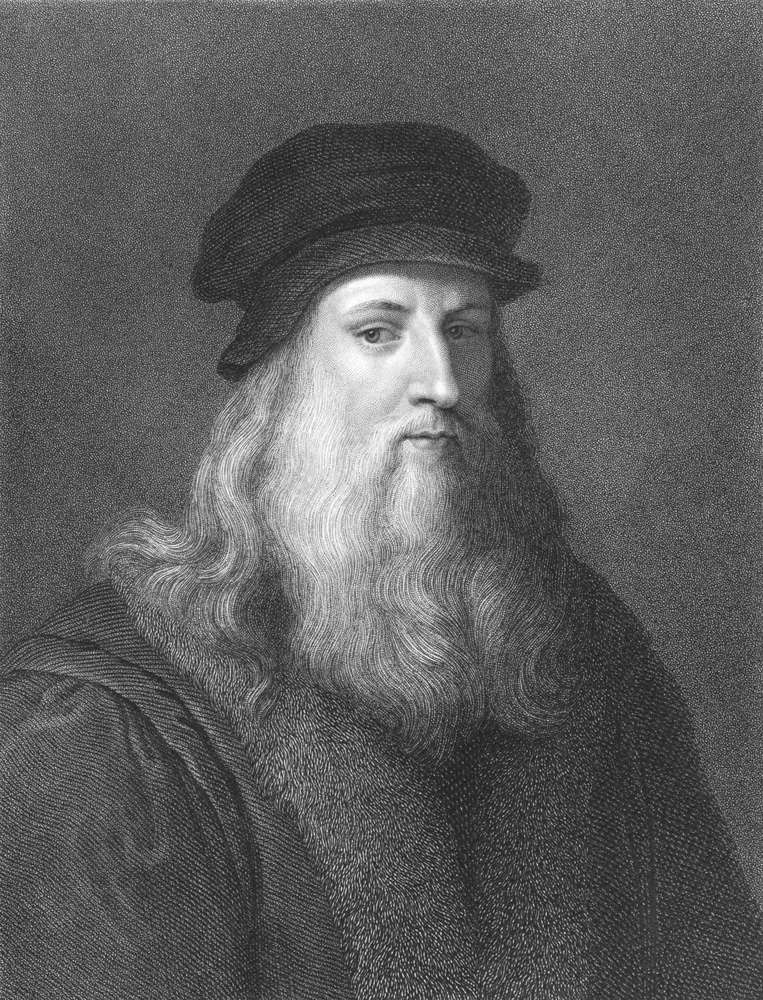
Leonardo Da Vinci (1452-1519) on engraving from the 1800s.
Facts about Leonardo da Vinci
Leonardo da Vinci’s paintings
- The Mona Lisa is one of the first portraits to display a person sitting in front of an imaginary landscape. Some historians believe that Lisa’s loose attire in the painting indicates that she was pregnant when Leonardo started painting the portrait.
- The Mona Lisa is the most iconic painting in the world. But Leonardo da Vinci never finished it. After his death, the French king Francis I acquired it. After many years, it was moved to the Versailles Palace in France. Then, Nepolean Bonaparte took it and kept it in his bedroom. Currently, it is in the Louvre Museum in Paris.
- The Mona Lisa is an oil painting on a wood panel.
- In 2017, Salvator Mundi, an oil painting of Jesus by Leonardo da Vinci, was sold for $450 million. Thus, it became the costliest painting in the world.
Leonardo da Vinci’s sculptures
- When it came to art, Leonardo devoted most of his time to painting than sculpting. But he was also a great sculptor. He planned meticulously and created preparatory sketches for a few sculptures. However, none of them were ever completed due to varied reasons. So, none of Leonardo da Vinci’s sculptures survive today.
Leonardo da Vinci’s notes
- Unlike other famous artists, Leonardo da Vinci did not paint a lot of paintings. Less than 20 paintings are attributed to him. However, he sketched a lot and kept meticulous notes on different subjects on the papers he carried with him. After his death, these papers were bound into notebooks. The total number of pages in all his notebooks combined is more than 7000.
- Leonardo was ambidextrous, i.e., he was skilled at using both hands for writing. However, he was initially left-handed. Whenever a left-hander writes on a sheet of paper, starting from left to right, ink from the already written text smears on his hand. So, probably to avoid that, Leonardo wrote backward, from right to left, using mirror writing. The text he wrote could only be read by looking at it through a mirror. Only when he intended other people to read the text he wrote did he write normally. That is the reason why he used mirror writing for the notes in the Vitruvian man. He probably sketched it for himself.
- Leonardo’s notebooks contain anatomical sketches, scientific designs, weapon designs, technical diagrams, and shopping lists. His most famous scientific designs were the designs of several flying machines that looked like a bird with flapping wings and another that looked like a helicopter, a design for a parachute, and a design for a giant crossbow.
Other facts
- Leonardo was an illegitimate son. So, he wasn’t able to inherit any of his father’s wealth, which was a lot. However, he used his father’s contacts to become a renowned artist.
- Leonardo Da Vinci was a procrastinator. While it made him a polymath, it also left several of his works unfinished.
“There are three classes of people: those who see. Those who see when they are shown. Those who do not see.”- Leonardo Da Vinci (Source)
What to read next?
We hope that you liked this biography of Leonardo da Vinci. If you liked this biography of Leonardo da Vinci, read the following biographies too:
1. Biography of Vincent Van Gogh
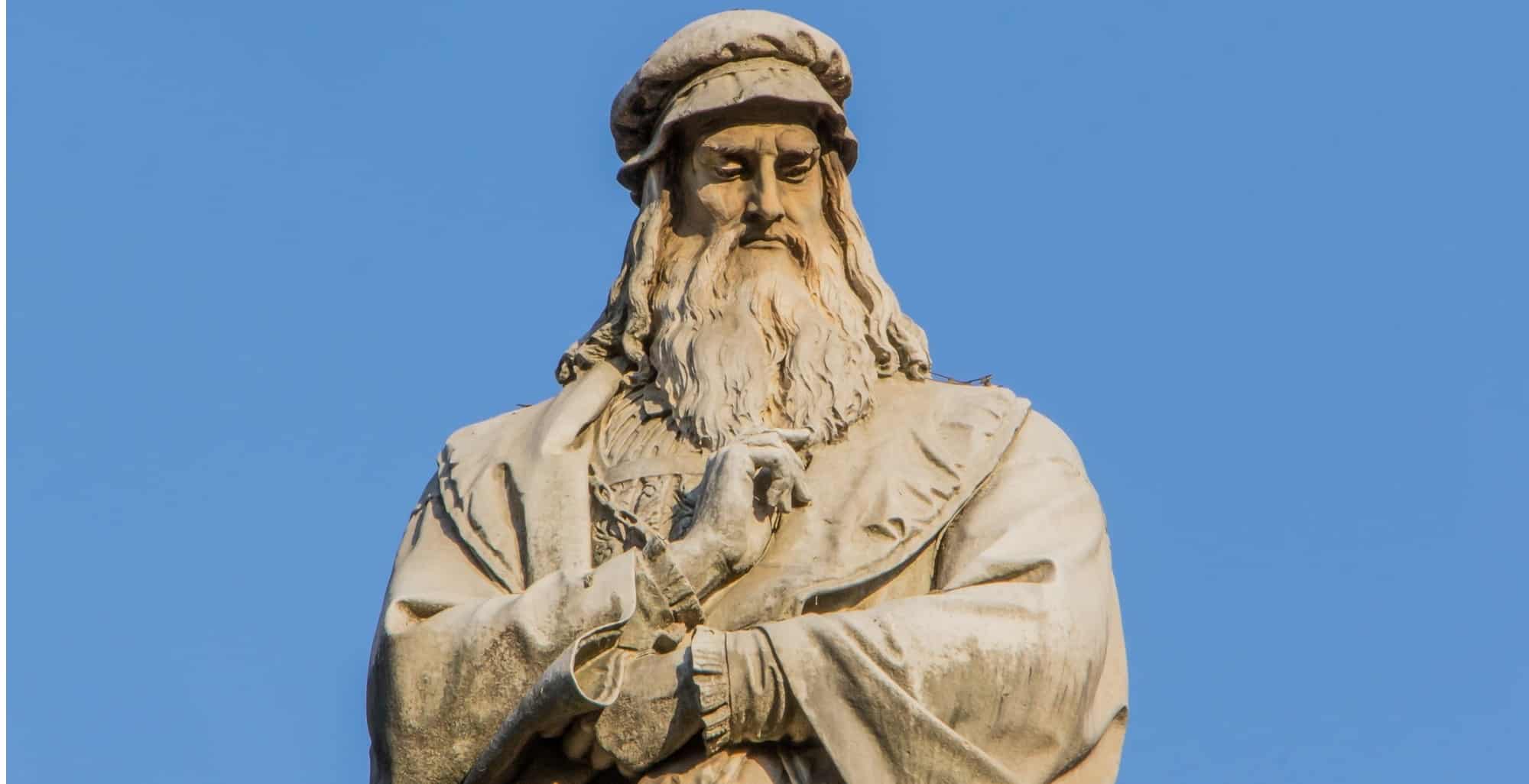

Leave a Reply